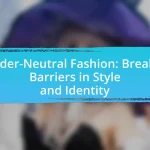Gender fluidity in fashion refers to the movement that allows individuals to express their identities beyond traditional male and female clothing norms. This article explores how gender fluidity challenges conventional fashion standards, promotes inclusivity, and reflects societal changes in gender perception. It examines the historical context that has shaped this movement, the impact of cultural attitudes on fashion, and the role of designers and brands in embracing gender-neutral styles. Additionally, it addresses the challenges faced by gender fluidity in the fashion industry, including societal barriers and stereotypes, while offering insights into how consumers and brands can advocate for and support this evolving trend.

What is Gender Fluidity in Fashion?
Gender fluidity in fashion refers to the concept where clothing and style are not confined to traditional gender norms, allowing individuals to express themselves beyond the binary classifications of male and female. This movement challenges conventional fashion standards by promoting a more inclusive approach that embraces a spectrum of gender identities. For instance, designers like Harris Reed and brands such as Gucci have incorporated gender-neutral collections, reflecting the growing acceptance and visibility of gender fluidity in contemporary fashion. This shift is supported by cultural changes and increased awareness of gender diversity, as seen in the rise of non-binary and genderqueer representation in media and society.
How does gender fluidity challenge traditional fashion norms?
Gender fluidity challenges traditional fashion norms by blurring the lines between male and female clothing, allowing individuals to express their identity beyond binary categories. This shift disrupts conventional expectations regarding what is deemed appropriate for each gender, leading to a more inclusive fashion landscape. For instance, designers like Harris Reed and brands such as Gucci have embraced androgynous styles, showcasing collections that incorporate elements traditionally associated with both genders. This movement reflects a growing societal acceptance of diverse gender identities, as evidenced by increased visibility in media and fashion shows, which further validates and normalizes gender fluid expression in everyday attire.
What historical context has shaped gender fluidity in fashion?
Historical context shaping gender fluidity in fashion includes the influence of various cultural movements and societal changes, particularly during the 20th century. The 1920s saw women adopting more masculine styles, such as trousers and shorter hemlines, reflecting the women’s suffrage movement and a push for gender equality. The 1960s and 1970s introduced androgyny in fashion, popularized by designers like Yves Saint Laurent, who launched the “Le Smoking” tuxedo for women, challenging traditional gender norms. Additionally, the LGBTQ+ rights movement in the late 20th century further normalized gender fluidity, as figures like David Bowie and Prince embraced androgynous aesthetics, influencing mainstream fashion. These historical shifts collectively contributed to the ongoing evolution of gender fluidity in fashion, demonstrating a continuous challenge to rigid gender binaries.
How do cultural perceptions influence gender fluidity in fashion?
Cultural perceptions significantly influence gender fluidity in fashion by shaping societal norms and expectations regarding gender expression. In cultures where traditional gender roles are rigidly defined, fashion tends to reinforce these binaries, limiting the acceptance of gender fluidity. Conversely, cultures that embrace diversity and inclusivity, such as those seen in urban centers or progressive societies, often promote fashion that allows for a blend of masculine and feminine elements. For instance, the rise of unisex clothing lines and gender-neutral fashion shows reflects a shift in cultural attitudes, as evidenced by brands like Telfar and gender-fluid models gaining visibility in mainstream media. This evolution indicates that as cultural perceptions evolve towards acceptance and celebration of gender diversity, fashion adapts to reflect and support these changes.
Why is gender fluidity important in contemporary fashion?
Gender fluidity is important in contemporary fashion because it challenges traditional gender norms and promotes inclusivity. This shift allows individuals to express their identities freely, breaking away from the binary constraints of male and female clothing. The rise of gender-neutral collections from major brands, such as Gucci and Balenciaga, illustrates this trend, reflecting a broader societal acceptance of diverse gender identities. Furthermore, studies indicate that 62% of Gen Z consumers prefer brands that embrace gender fluidity, highlighting its significance in appealing to modern audiences.
What impact does gender fluidity have on fashion inclusivity?
Gender fluidity significantly enhances fashion inclusivity by challenging traditional gender norms and promoting a broader acceptance of diverse identities. This shift allows for a more expansive range of styles and expressions, enabling individuals to choose clothing that resonates with their personal identity rather than conforming to binary gender expectations. For instance, brands like Gucci and Telfar have embraced gender-neutral collections, reflecting a growing market demand for inclusivity. According to a 2021 report by McKinsey & Company, 67% of consumers believe that brands should represent a diverse range of gender identities in their marketing and product offerings, illustrating the positive impact of gender fluidity on fashion inclusivity.
How does gender fluidity promote self-expression in fashion?
Gender fluidity promotes self-expression in fashion by allowing individuals to transcend traditional gender norms and embrace a diverse range of styles that reflect their personal identity. This fluidity encourages creativity and experimentation, enabling people to mix and match clothing typically associated with different genders, thus fostering a more inclusive fashion landscape. Research indicates that the rise of gender-neutral clothing lines and the visibility of gender-fluid influencers have significantly influenced mainstream fashion, leading to a broader acceptance of varied expressions of gender. For instance, brands like Telfar and Palomo Spain have gained recognition for their gender-inclusive designs, demonstrating that fashion can be a powerful medium for self-expression beyond binary classifications.

What are the key elements of gender fluid fashion?
The key elements of gender fluid fashion include versatility, inclusivity, and the rejection of traditional gender norms. Versatility allows clothing to be worn by individuals regardless of gender, often featuring unisex designs that prioritize comfort and personal expression. Inclusivity is reflected in the acceptance of diverse body types and styles, promoting a broader range of fashion choices that cater to all identities. The rejection of traditional gender norms is evident in the blending of masculine and feminine aesthetics, encouraging individuals to mix and match elements traditionally associated with either gender. These elements collectively foster a fashion landscape that embraces fluidity and self-expression, aligning with contemporary societal shifts towards gender inclusivity.
What types of clothing are associated with gender fluidity?
Clothing associated with gender fluidity includes a mix of traditionally masculine and feminine garments, such as oversized shirts, tailored blazers, skirts, and unisex jeans. This blend allows individuals to express their identity beyond binary gender norms. For instance, the rise of brands like Telfar and Rad Hourani showcases collections that intentionally blur gender lines, offering styles that cater to all genders. Additionally, the popularity of androgynous fashion icons, such as Billy Porter and Jaden Smith, further validates the acceptance of diverse clothing choices that reflect gender fluidity.
How do unisex and androgynous styles contribute to gender fluidity?
Unisex and androgynous styles contribute to gender fluidity by challenging traditional gender norms and allowing individuals to express their identities beyond binary classifications. These styles promote inclusivity by offering clothing options that do not conform to conventional male or female aesthetics, thereby enabling people to navigate their gender identity more freely. Research indicates that the rise of unisex fashion has been linked to a broader societal acceptance of diverse gender expressions, as seen in brands like Telfar and Rad Hourani, which intentionally design garments that appeal to all genders. This shift in fashion reflects and reinforces the growing recognition of gender fluidity in contemporary culture.
What role do accessories play in gender fluid fashion?
Accessories play a crucial role in gender fluid fashion by allowing individuals to express their identity beyond traditional gender norms. They serve as versatile tools for personal expression, enabling wearers to mix and match styles that reflect their unique gender identity. For instance, items like jewelry, bags, and hats can be used to challenge conventional gender presentations, as seen in the rise of unisex accessories that appeal to a broad audience. This adaptability is supported by the increasing popularity of brands that focus on gender-neutral designs, highlighting the shift towards inclusivity in fashion.
How do designers incorporate gender fluidity into their collections?
Designers incorporate gender fluidity into their collections by creating garments that are not restricted by traditional gender norms, often utilizing unisex designs, versatile silhouettes, and inclusive sizing. For instance, brands like Rad Hourani and Telfar have gained recognition for their gender-neutral clothing lines that appeal to a diverse audience, allowing individuals to express their identity without conforming to binary classifications. This approach is supported by a growing consumer demand for inclusivity in fashion, as evidenced by a 2021 report from McKinsey & Company, which highlighted that 67% of Gen Z consumers prefer brands that reflect their values, including gender inclusivity.
What are some notable brands that embrace gender fluid fashion?
Notable brands that embrace gender fluid fashion include Gucci, Telfar, and Rad Hourani. Gucci has been recognized for its gender-neutral collections, particularly under the creative direction of Alessandro Michele, who has blurred traditional gender lines in fashion. Telfar, known for its unisex designs and inclusive approach, has gained significant popularity for its accessible luxury. Rad Hourani is celebrated for pioneering unisex clothing, emphasizing a modern aesthetic that transcends gender norms. These brands exemplify the shift towards inclusivity and the breaking of traditional fashion boundaries.
How do fashion shows reflect gender fluidity trends?
Fashion shows reflect gender fluidity trends by showcasing collections that blur traditional gender lines, featuring designs that are not exclusively male or female. Designers like Gucci and Balenciaga have embraced unisex clothing, presenting garments that can be worn by anyone regardless of gender identity. This shift is evidenced by the increasing number of models of diverse gender identities on the runway, as seen in the 2021 Spring/Summer collections where gender-neutral styles were prominently displayed. Such representations challenge conventional norms and promote inclusivity, aligning with broader societal movements towards acceptance of gender fluidity.

What challenges does gender fluidity face in the fashion industry?
Gender fluidity in the fashion industry faces significant challenges, primarily due to entrenched gender norms and a lack of representation. Traditional fashion marketing often targets specific gender identities, limiting the visibility and acceptance of gender-fluid designs. According to a 2021 report by McKinsey & Company, only 15% of fashion brands actively promote gender-neutral clothing, indicating a gap in market offerings. Additionally, societal stigma and misunderstanding surrounding gender fluidity can lead to discrimination and exclusion within retail environments, further complicating acceptance. These barriers hinder the growth and integration of gender-fluid fashion, making it difficult for designers and consumers to fully embrace this evolving identity.
What societal barriers exist against gender fluid fashion?
Societal barriers against gender fluid fashion include rigid gender norms, discrimination, and lack of representation. Rigid gender norms dictate that clothing should align with traditional male or female identities, limiting acceptance of gender fluid styles. Discrimination manifests in social stigmas and biases, leading to negative reactions from peers and institutions, which can discourage individuals from expressing their gender identity through fashion. Additionally, the fashion industry often lacks representation of gender fluid individuals, making it difficult for diverse styles to gain visibility and acceptance. These barriers collectively hinder the acceptance and normalization of gender fluid fashion in society.
How do stereotypes affect the acceptance of gender fluidity in fashion?
Stereotypes significantly hinder the acceptance of gender fluidity in fashion by reinforcing rigid gender norms that dictate appropriate clothing choices for individuals based on their perceived gender. These stereotypes create societal pressure to conform to traditional gender roles, which often marginalizes those who express their identity outside of these norms. For instance, a study published in the Journal of Fashion Marketing and Management found that individuals who defy gender norms in their fashion choices often face social stigma and discrimination, which can discourage self-expression and limit the visibility of gender fluidity in mainstream fashion. This societal bias not only affects individual choices but also influences designers and brands, leading to a lack of representation and inclusivity in fashion collections.
What role does media representation play in shaping perceptions of gender fluidity?
Media representation plays a crucial role in shaping perceptions of gender fluidity by normalizing diverse gender expressions and challenging traditional binary notions of gender. Through various platforms, such as television, film, and social media, representations of gender fluid individuals help to increase visibility and acceptance, thereby influencing societal attitudes. For instance, the portrayal of gender-fluid characters in popular shows like “Billions” and “Pose” has contributed to a broader understanding of gender as a spectrum rather than a fixed binary. Research indicates that increased representation correlates with greater acceptance; a study published in the Journal of Social Issues found that exposure to diverse gender identities in media can reduce prejudice and foster inclusivity.
How can the fashion industry evolve to support gender fluidity?
The fashion industry can evolve to support gender fluidity by embracing inclusive design practices that cater to a diverse range of gender expressions. This includes creating unisex clothing lines, utilizing non-binary models in advertising campaigns, and promoting brands that prioritize gender-neutral aesthetics. For instance, brands like Telfar and Rad Hourani have successfully launched collections that defy traditional gender norms, demonstrating market demand for such offerings. Additionally, research from the Gender and Fashion Studies Journal indicates that consumers increasingly seek brands that reflect their values of inclusivity and diversity, reinforcing the need for the fashion industry to adapt to these changing societal expectations.
What initiatives can brands take to promote gender fluidity?
Brands can promote gender fluidity by implementing inclusive marketing strategies, creating gender-neutral product lines, and fostering diverse representation in advertising. Inclusive marketing strategies involve using language and imagery that resonate with all gender identities, which can enhance brand loyalty among diverse consumers. Developing gender-neutral product lines, such as clothing that is not specifically designed for men or women, allows brands to cater to a broader audience and reflects the growing demand for non-binary fashion options. Additionally, fostering diverse representation in advertising campaigns, including models of various gender identities, can challenge traditional norms and promote acceptance of gender fluidity. These initiatives align with current societal shifts towards inclusivity and have been shown to positively impact brand perception and consumer engagement.
How can consumers advocate for gender fluidity in fashion?
Consumers can advocate for gender fluidity in fashion by supporting brands that promote inclusive designs and challenging traditional gender norms. By purchasing from companies that offer gender-neutral clothing lines, consumers signal demand for diversity in fashion. Additionally, consumers can use social media platforms to raise awareness about gender fluidity, share personal experiences, and promote brands that align with these values. Research indicates that 62% of consumers prefer brands that reflect their values, highlighting the impact of consumer choices on brand practices.
What practical tips can individuals follow to embrace gender fluidity in their wardrobe?
Individuals can embrace gender fluidity in their wardrobe by incorporating versatile pieces that defy traditional gender norms. This can include selecting clothing items such as oversized shirts, tailored blazers, and unisex accessories that can be styled in multiple ways. Additionally, individuals should experiment with layering techniques to combine traditionally masculine and feminine elements, creating a unique personal style. Research indicates that the rise of gender-neutral fashion lines, such as those from brands like Telfar and Rad Hourani, reflects a growing acceptance of fluidity in clothing choices, allowing individuals to express their identity without conforming to binary standards.

















